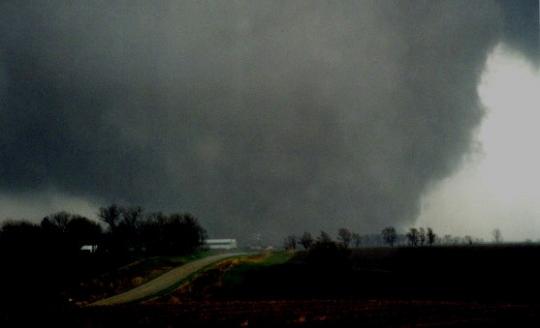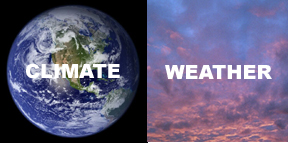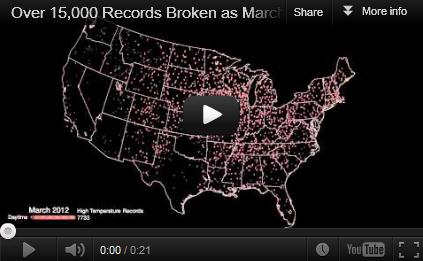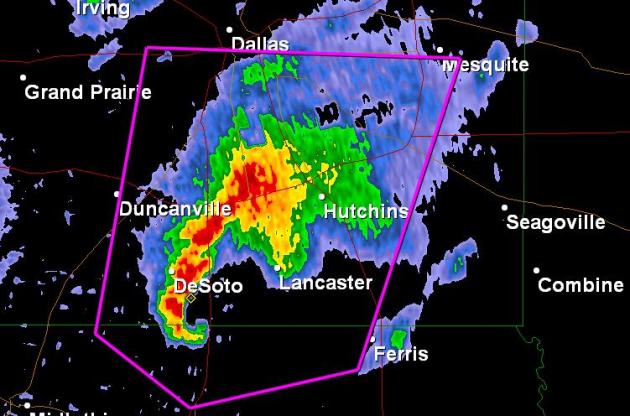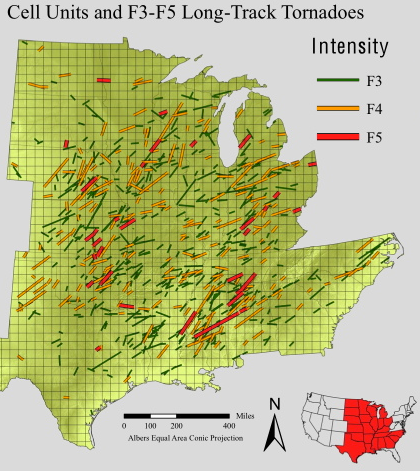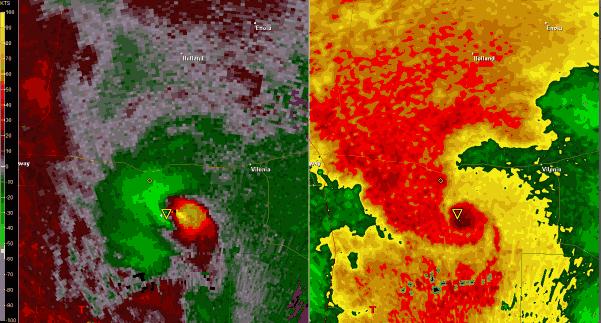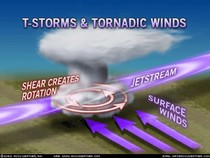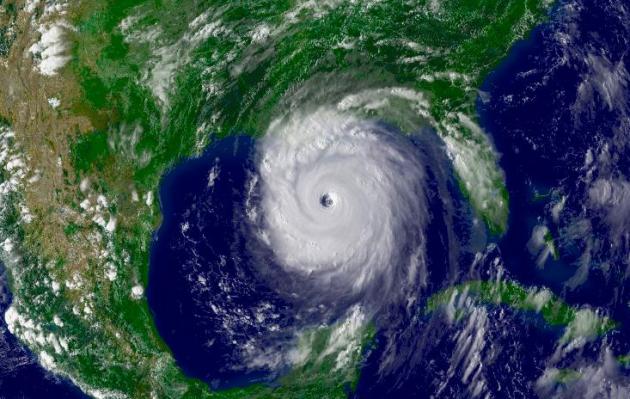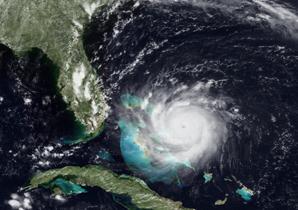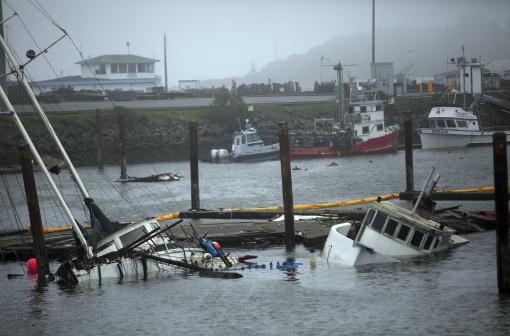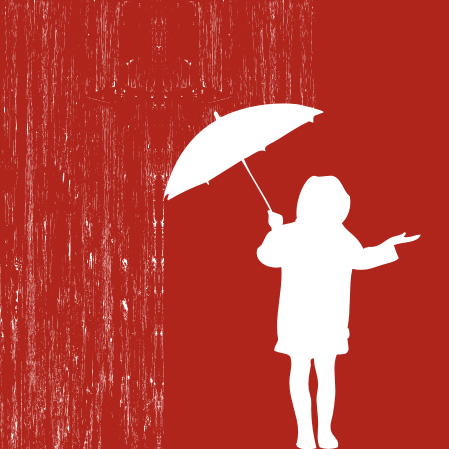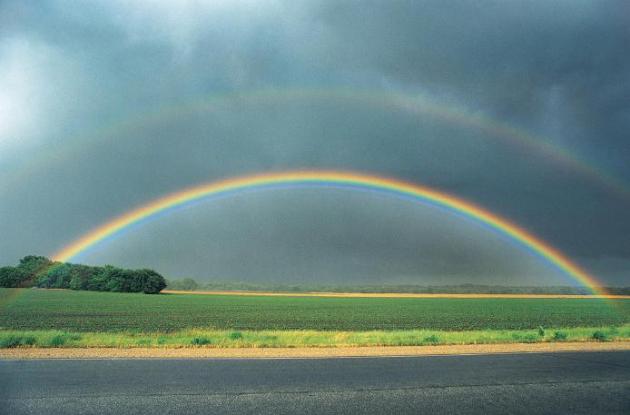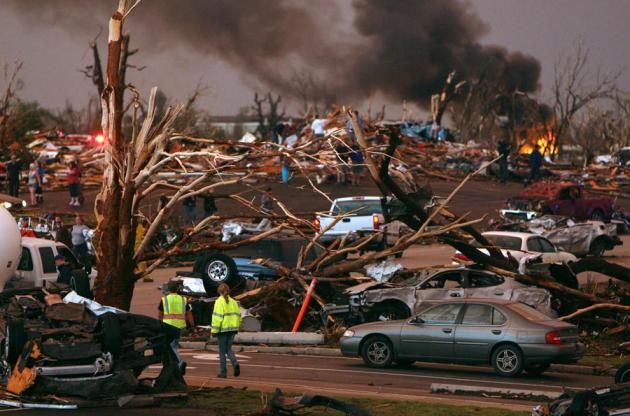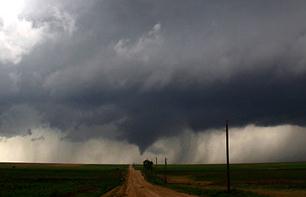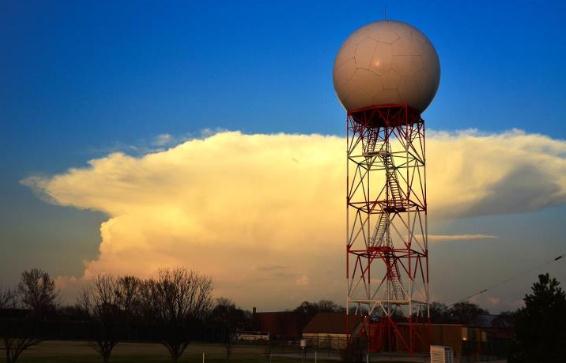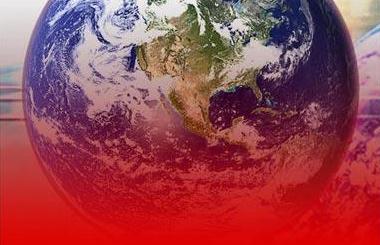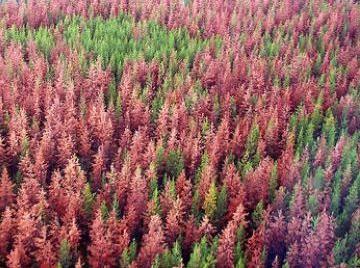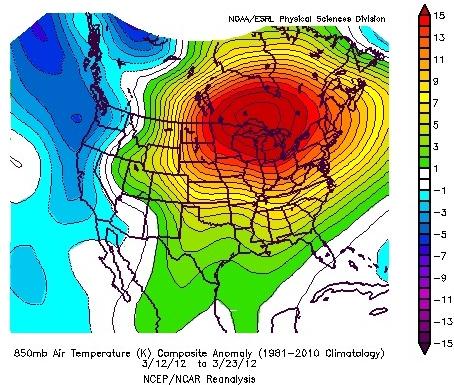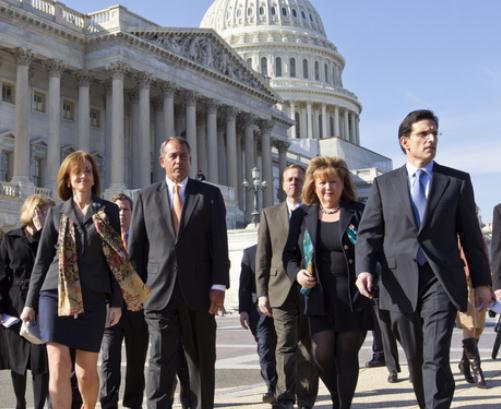"
Some experts cautioned that using language that is too strong could have the opposite of its intended effect. Jeff Lazo, director of the Societal Impacts Program at the National Center for Atmospheric Research in Colorado, said people could actually go into "fear control." "Instead of responding to a threat, they just kind of tune it out," Lazo said. "It's not necessarily a rational response. It's more of an emotional response. There comes a point where someone's just going to grab a six pack and go to the roof because they don't think they're going to survive it."- from a timely AP story at weatherbug.com below.
“The climate has shifted to a new state capable of delivering rare & unprecedented weather events." - Weather Underground's Dr. Jeff Masters, in a Think Progress article below.
“
Most people in the country are looking at everything that’s happened; it just seems to be one disaster after another after another,” said Anthony A. Leiserowitz of Yale University, one of the researchers who commissioned the new poll. “People are starting to connect the dots.” - excerpt from a New York Times article; details below.
A March Like No Other. From an article at
The Christian Science Monitor: "
According to NOAA scientists at the National Climatic Data Center (http://www.ncdc.noaa.gov/sotc/), record and near-record breaking temperatures dominated the eastern two-thirds of the nation and contributed to the warmest March on record for the contiguous United States, a record that dates back to 1895. This animation shows the locations of each of the 7,755 daytime and 7,517 nighttime records (or tied records) in sequence over the 31 days in March."
1 in 3 Americans have been impacted by extreme weather, according to findings of a recent national poll.
4% increase in relative humidity, worldwide, in the last 30 years - meaning more moisture for floods and weather extremes.
"The fact that it's impossible to draw a straight line between climate change and the seemingly more turbulent weather doesn't mean we should act as if the two aren't linked. There's no doubt that warming raises at least the risk of extreme-weather events, something we're thinking about more in the early part of what is shaping up to be a brutally hot year in the U.S." - excerpt from an article about extreme weather and climate change from Time Magazine below.
"Americans, thus, correctly accept the idea global warming should make the weather warmer and precipitation events a bit more extreme. They may overreach in connecting individual weather events to climate change, but these connections are complex and it’s probably not reasonable to expect most people to unravel all of the intricacies." excerpt from meteorologist Jason Samenow in The Capital Weather Gang - details below.
1980 to 2009. Florida, Iowa, Louisiana and Mississippi and Kansas experienced the most tornadoes in the USA. Source:
CoreLogic.
1,000 of Texas' 4,710 community water systems are currently under water restrictions. More in The Denver Post below.
Drought Expands Across The USA.
America hasn't been this dry in 5 years, according to NOAA's
Drought Monitor. USA Today has details
here.
Could Better Tornado Warnings Lead To Complacency? An interesting story from AP and
Weatherbug.com: "
OKLAHOMA CITY - Forecasters who issued dire warnings ahead of last weekend's tornado outbreak in the Midwest deemed the effort a success Monday, largely because dozens of tornadoes hit yet caused only a handful of deaths. But they expressed concern about future public complacency. The National Weather Service's Storm Prediction Center issued a rare high-risk warning days ahead of the storms, sternly urging residents across several states to prepare for "life-threatening" weather. State officials and residents in communities where tornadoes hit praised the effort, noting only six lives were lost. But many of the tornadoes touched down in rural areas, mostly in Kansas. Forecasters worried that could result in people tuning out future warnings because they were not in this outbreak's path."
Tornado Threat Actually Much More Widespread Than "Tornado Alley". Here's an excerpt of a story from
KJRH.com: "
Yes, Oklahoma is smack-dab in the middle of the so-called "Tornado Alley," but now nearly a dozen other states are facing the same moniker. A new report suggests the traditional Tornado Alley boundaries, which includes Oklahoma, Texas, Kansas, Nebraska and South Dakota, should be expanded. The report by CoreLogic , a private research and consulting company, says much of the Midwest, the Deep South and Florida should be included in Tornado Alley because of the frequency and severity of tornadoes in those areas."
Map above courtesy of Michael Frates, University of Akron. More information
here.
Kansas Officials Call Some Storm Chasers "Outrageously Stupid." It's not good when emergency responders can't get to the scene of tornado damage because of hundreds of storm chasers clogging highways. The story from
USA Today.
The Wind At Your Door, Literally. Americans have a fascination with tornadoes and tornado-chasing. They are nature's most fickle and fascinating wind - but the adrenaline rush, the thrill of seeing a tornado, quickly goes away when you wander through the rubble leftover from a large tornado. Here's an excerpt of a compelling story from
The Baltimore Sun: "
In the poem “The Wind at Your Door,” R.D. Fitzgerald references the atrocities of the past blowing into present day Australian society. Despite the differences in subject matter, not to mention continents, I couldn’t help but think about this poem while reading about the deadly storms this past weekend. Being from Iowa, tornadoes have always been a threat from April to August. The horrendous tornado damage to the town of Parkersburg in 2008 was only 25 miles from where I grew up. Imagine my surprise to read that I’m more likely to witness a tornado since moving to Baltimore because Maryland is third on the list of “Top Tornado States.”
Photo credit above: "
A tornado on the ground makes it way through the night near Salin, Kansas, during the third day of severe weather and multiple tornado sightings, April 14, 2012. A spate of tornadoes tore through parts of Oklahoma, Kansas, Nebraska and Iowa, churning through Wichita and other areas, causing widespread damage and killing two. (Gene Blevins/Reuters) PHOTO LINK."
Before the Tornado...
Tornado watches highlight the area where tornadoes are most likely to develop. Continue with your normal activities, but keep informed of the latest weather information and be ready to get to shelter in case tornadoes develop quickly.
In the Home...
Go to the basement if possible. Get under a table, work bench, or some other sturdy furniture to avoid falling debris. A stairwell is also a good place to hide during a tornado.
If You Cannot Get to a Basement...
Go to a small interior room on the lowest floor. Closets, bathrooms, and interior halls afford the best protection in most cases, or try to hide under a bed. Get under something sturdy or cover yourself with blankets. Stay away from windows.
In an Apartment, School or Office Building...
Move to the inner-most room on the lowest level or to a pre-designated shelter area. Stay away from windows. If in a hallway, crouch down and protect your head from flying debris. Avoid areas with glass and large roof expansions.
In a Mobile Home, Car, Truck or Other Vehicle...
Abandon these as quickly as possible. Seek a sturdy shelter or permanent structure. Remember that many deaths occur when people try to drive away in a vehicle, but get caught in the deadly winds. Avoid bridges since they act as wind tunnels.
High-Resolution Winds Across The USA. Back by popular demand, this is actually a high-resolution short-term forecast of wind speed/direction, based on NOAA's NDFD - courtesy of
hint.fm. You can click on the link to get this up on your browser - zoom into specific regions and a pop-up window gives you forecast wind direction/speed wherever you place your cursor. This is one of the best visualizations of weather information I've ever seen - anywhere.
Light Jackets Give Way To Shorts Next Week. The CPC (Climate Prediction Center) 6-10 day temperature trend (upper left) and 8-14 day trend (upper right) shows a continued warm bias for much of America east of the Rockies. Not as dramatic as March, but some 70s are likely from Tuesday through Sunday of next week. Map courtesy of NOAA and
Ham Weather.
Hurricane Preparedness: Keeping An Emergency From Becoming A Disaster. Here's an excerpt of a good article from DVIDS,
The Defense Video And Distribution System: "
Hart also suggested making a record of personal property. Take photographs or videotapes of belongings and store these documents in a safe place. Here are some steps to prepare for a hurricane from www.fema.gov:
• Make plans to secure your property. Permanent storm shutters offer the best protection for windows. A second option is to board up windows with about 5/8-inch-thick marine plywood, cut to fit and ready to install.
• Install straps of additional clips to securely fasten your roof to the frame structure. This will reduce roof damage.
• Be sure trees and shrubs around your home are well-trimmed.
• Clear loose and clogged rain gutters and down spouts.
• Determine how and where to secure your boat (if you have one).
• Consider building a safe room."
* Image of Hurricane Katrina (2005) above courtesy of NASA and NOAA.
NOAA Retires GOES-7 After 25 Years As A Weather And Communications Satellite. Details from
NOAA: "
This week, the GOES-7 satellite, one of NOAA’s earliest geostationary satellites, was moved into a higher orbit and retired from service. Launched in 1987, GOES-7 first served as a critical weather satellite, capturing images of developing hurricanes and other severe storms that impacted the United States. In 1999, when its Earth-observing instruments degraded past operational use, the Pan-Pacific Education and Communication Experiments by Satellite (PEACESAT) program began using GOES-7 to provide communications for the Pacific islands.'
Photo credit above: "This image from the GOES-7 satellite shows Hurricane Andrew at its peak intensity on August 24, 1992 before making landfall near Homestead, FL." Source: NOAA.
Tsunami Alert: Don't Cut That Program. Not something we need to worry about in Minnesota (one of the FEW things we don't have to fret about), but tsunamis (tidal waves) are a constant risk to the west coast; vulnerable to offshore quakes which can displace vast amounts of water - increasing the potential for a disastrous tsunami. The
L.A. Times has more: "
After last week's earthquake in the Indian Ocean, people in Indonesia responded far differently than they had seven years earlier, after another major quake: They evacuated low coastal areas to escape a possible tsunami. As it turned out, there were no killer tidal surges for various reasons, including the type of earth movement involved. Still, the response was a welcome improvement. The 2004 earthquake and tsunami killed close to 200,000 people in Southeast Asia; many of those victims had no idea of the impending danger. And the change this time was due in good part to an Indian Ocean tsunami warning system put in place since that catastrophe."
Photo credit above: "
Sunken fishing boats in the harbor after tsunami swells from the earthquake in Japan last week stuck the area in heights of up to eight feet, in Crescent City, Calif., March 15, 2011. The city has long been known as one of the nation’s most susceptible inlets when it comes to tsunami, and this past week's tsunami has left damages believed to be in the tens of millions of dollars, shutting down one of Northern California’s most lucrative fishing operations. (Jim Wilson/The New York Times)."
"Ask Paul." Weather-related Q&A:
"
I need to know what the rainfall in Eden Prairie has been since November 1, 2011. It’s for a client of mine. I have checked everywhere I can think of and all the sites want money to give me that information. Is this something you can help me with or can you recommend a good website where I can find that information."
Thank you.
Gayle
Gayle Dungey
Caldwell Banker Burnet
Gayle - I passed your request on to Pete Boulay at the Minnesota Climatology Working Group. The closest we can get with reliable data is Chanhassen - hopefully that will be close enough for your precipitation needs. The answer, by the way, is 12.34" of precipitation for the Chanhassen/Eden Prairie area since November 1, 2011.
Welcome Puddles
No more "risk of rain" or "threat of showers". So often we use a pejorative when describing expected weather; the assumption that (most) people dislike puddles, especially on a weekend - when more of us are at the mercy of the elements. In spite of recent rains 99 percent of Minnesota is still "abnormally dry"; NOAA's Drought Monitor shows nearly a quarter of the state in severe drought. Plants and crops have "first mortgage" on any rain - we need about 3-6 inches of water to get lake water levels back up to where they should be.
So I won't moan and groan about today's showers. We dry out a bit Friday, but a nearby frontal boundary, coupled with a nagging swirl of cold air aloft, will keep clouds and showers overhead Saturday - Sunday looks like the sunnier, drier, nicer day of the weekend. Monday looks stunning (naturally). We may hit 70 by next Tuesday - the first chance of severe T-storms not until next Thursday.
This is Severe Weather Awareness Week in Minnesota. Although I still think a dry bias may prevent us from seeing a rerun of 2010's craziness (145 tornadoes in Minnesota!) we all need to be prepared. That means a NOAA Weather Radio, smartphone apps and e-mail alerts.
The more sources of severe information - the better.
Climate Stories...
Has Global Warming Caused A Quantum Jump In Extreme Weather? Here's an excerpt from an article at
ThinkProgress.com: "
Increasingly, scientists and meteorologists are asking whether global warming is driving a quantum jump — a non-linear shift — in our extreme weather. We now have enough observations and analyses that a scientific literature on this subject has begun to emerge:
Peter Sinclair has put together an excellent video for the Yale Forum on why even the modest 1°C warming we’ve seen over the past century can cause a disproportionally large shift in our weather systems."
 Americans Connect Dots Between Extreme Weather And Climate Change
Americans Connect Dots Between Extreme Weather And Climate Change.
The Capital Weather Gang's Jason Samenow has an excellent post in The Washington Post; here's an excerpt: "
Most Americans get it: global warming is intensifying heat waves and extreme precipitation to some degree. That’s the take away from a new public opinion survey from the Yale Project on Climate Change Communication and George Mason University Center for Climate Change Communication. The survey, which queried more than 1,000 adults across the country about global warming and extreme weather, discovered roughly two-thirds of Americans believe global warming is linked to several of the extreme weather events of 2011 and the recent mild winter. Predictably, this news has drawn the full spectrum of reactions."
Photo from my book, "Restless Skies, The Ultimate Weather Book", courtesy of Sterling Publishing.
In Poll, Many Link Weather Extremes With Climate Change. Here's an excerpt of a story at
The New York Times: "
Scientists may hesitate to link some of the weather extremes of recent years to global warming — but the public, it seems, is already there. A poll due for release on Wednesday shows that a large majority of Americans believe that this year’s unusually warm winter, last year’s blistering summer and some other weather disasters were probably made worse by global warming. And by a 2-to-1 margin, the public says the weather has been getting worse, rather than better, in recent years." Photo credit above: AP.
The Weekend Of 100 Tornadoes: Are Killer Storms Being Fueled By Climate Change? Here's a good, in-depth article from
Time Magazine: "
It could have been so much worse. Over 100 tornadoes ripped through several Plains states in just 24 hours over the weekend. Cars were tossed through the air and houses were pulverized. Hail the size of baseballs fell from the sky, crushing anything left in the open. More than what is ordinarily a month's worth of cyclones struck in a single day, yet miraculously, only one, in the Oklahoma town of Westwood, proved fatal, killing six victims who lived in and around a mobile-trailer park. "God was merciful," Kansas Governor Sam Brownback told CNN on Sunday. But it wasn't just God or chance. The low death toll was also due to a faster and more insistent warning system by weather forecasters, who put the word out early and often and over many platforms that the past weekend could be a dangerous one for the Midwest, thanks to an unusually strong storm system."
Photo credit above: "
A tornado makes its way through farmlands near Rush Center, Kansas, on April 14, 2012. Over 100 tornadoes ripped through several Plains states in just 24 hours that weekend." Gene Blevins / Reuters.
Extreme Weather And Climate Change. Here's more from the
Yale Project On Climate Change Communication:
- 82 percent of Americans report that they personally experienced one or more types of extreme weather or a natural disaster in the past year;
- 35 percent of all Americans report that they were personally harmed either a great deal or a moderate amount by one or more of these extreme weather events in the past year;
- Over the past several years, Americans say the weather in the U.S. has been getting worse – rather than better – by a margin of over 2 to 1 (52% vs. 22%)."
* photo above: Chicago office of the National Weather Service.
Global Warming: Sea Ice Decline Causing Ozone Depletion. Here's an excerpt from a story at
The Summit County Citizens Voice: "
SUMMIT COUNTY — Loss of sea ice in polar regions isn’t just affecting the surface of the Earth, but is also having an impact on the atmosphere. An international NASA-led team, coordinated by the National Ice Center, is reporting that changes in sea ice are driving chemical reactions that result in ozone depletion and the toxic element mercury falling out of the Arctic atmosphere onto the ocean and icy surface. The findings may help explain why other studies documented an unprecedented loss of ozone in the Arctic last winter."
Global Warming Is Not A Hoax. From
The Bismarck Tribune:
-- "
Both the U.S. and Canada are developing technologies to better track increased shipping traffic in the Arctic.
-- Shell Oil is exploring for oil and natural gas in the Beaufort Sea, just north of Alaska, and Exxon Mobile has just signed a deal with the Russians to do the same thing in their Arctic waters.
-- In 2009, because “evidence indicates that the Earth’s climate is changing, and the most rapid changes are occurring in the Arctic,” the U.S. Navy created Task Force Climate Change to help naval leaders deal with the significant climatic changes in the Arctic.
-- The Pacific island nation of Kiribati is negotiating to buy land on the island of Fiji so it will have some place to move its 113,000 people before the Pacific Ocean inundates the entire nation (the first of thousands of islands so threatened)."
Climate Change Throws Nature's Timing Out Of Whack. Details from MNN,
Mother Nature Network: "
Timing matters: Flowers bloom, insects emerge, birds migrate, and planting and hunting seasons are carefully coordinated times in order to take advantage of what other organisms, or the weather, is up to. But increasing research is showing some of these relationships are falling out of sync as climate change alters important cues, such as the arrival of spring warmth. "There are going to be winners and losers," said David Inouye, a biology professor at the University of Maryland, who has followed seasonal events at the Rocky Mountain Biological Laboratory in Colorado since 1973. "The ultimate outcome will be that some species go extinct and some manage to adapt."
Goodman: The Long, Hot March Of Climate Change. Here's an excerpt of an Op-Ed at
The Denver Post: "
The Pentagon knows it. The world's largest insurers know it. Now, governments may be overthrown because of it. It is climate change, and it is real. According to the U.S. National Oceanic and Atmospheric Administration, last month was the hottest March on record for the U.S. since 1895, when records were first kept, with average temperatures of 8.6 degrees Fahrenheit above average. More than 15,000 March high temperature records were broken nationally. Drought, wildfires, tornadoes and other extreme weather events are already plaguing the country."
Goldmark: No Time To Waste On Warming. An Op-Ed at
Newsday.com: "
The sea level is rising and the clock is ticking. It's time to come to our senses about global warming. The concentration of greenhouse gases in the Earth's atmosphere increases relentlessly, but slowly. The greatest asset we have in dealing with it is time: time to phase in carbon limits carefully, time to make sure we don't burden the economy with emergency measures, and time to work out agreements with other countries -- since this is one of those new global problems where either we all succeed in addressing it together or we all suffer severe consequences separately. In the United States, we've been squandering that time with a senseless and paralyzing argument about whether global warming is real and if so, man-made."
Political Scientist: Republicans Most Conservative They've Been In 100 Years. And yes, for the record, not that it matters for anything, I'm a (moderate Republican). Oxymoron? Here's an excerpt from
NPR: "
When President Obama recently complained to news media executives about their ostensibly even-handed "pox on both of your houses" coverage of the partisan battles in Washington, it might have seemed like, well, a partisan shot from a Democratic president. After all, his complaint was that the GOP had moved so far right, and intransigently so, that it was wrong to create a false "equivalence" by blaming both parties equally for the Washington gridlock. To a skeptic that comment, coming from a Democrat, sounded suspiciously partisan itself."
Photo credit above:
J. Scott Applewhite/AP. "Congressional Republicans have a unique achievement, they are further from the political center than their predecessors of the past century."
